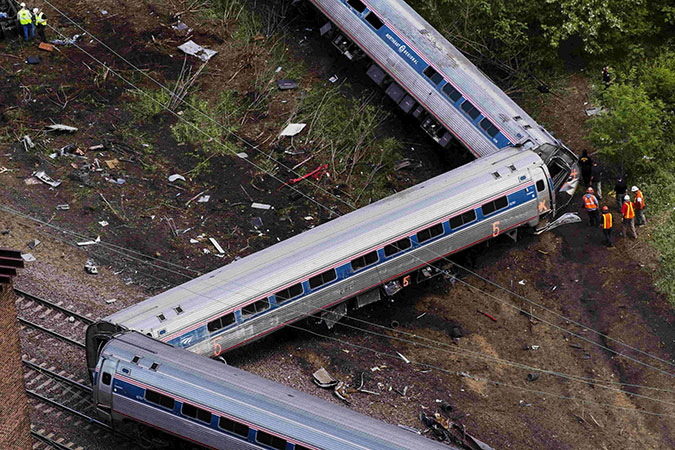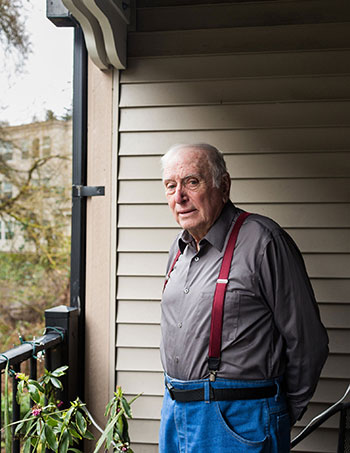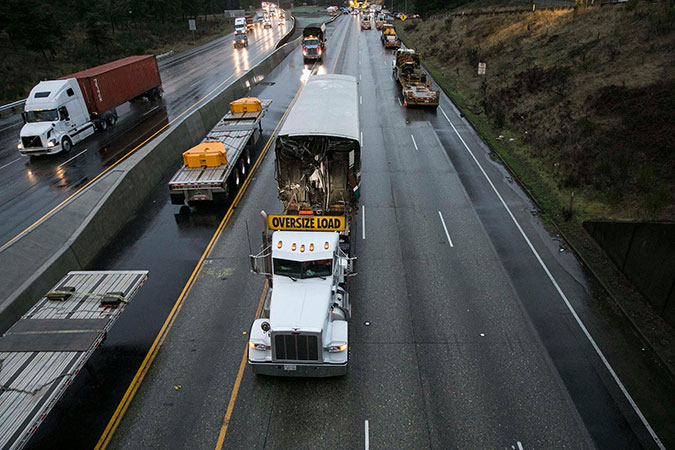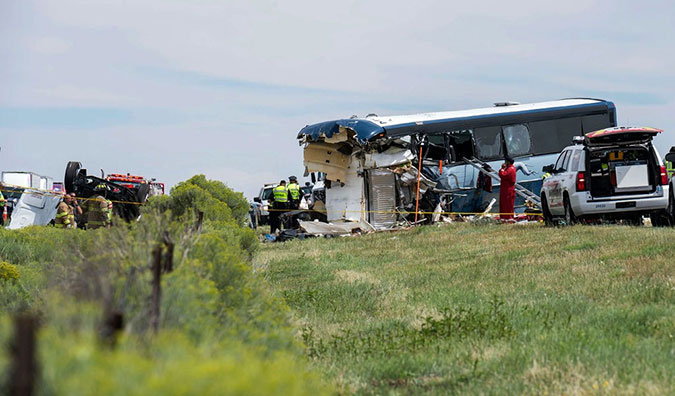
Emergency crews inspected a derailed Amtrak train in Philadelphia in 2015, an accident that left eight people dead. Lucas Jackson/Reuters.
April 8, 2019
By JOSHUA BROCKMAN
Serious train and bus accidents are rare. But when they happen, passengers and their bags have almost none of the protections considered standard on planes and cars.
The National Transportation Safety Board has long recommended a variety of measures to improve passenger safety, including installing lap-shoulder seatbelts, requiring riders to buckle up and improving window safety and overhead baggage restraints.
“Current safety standards for locomotive cabs and rail passenger cars are inadequate,” the N.T.S.B. said in February when it unveiled its “most wanted” list of safety improvements for trains. “Protecting passengers and crews from injury requires keeping rail car windows intact and maintaining their structural integrity during an accident, and includes occupant restraint systems, such as seatbelts, to mitigate the severity of passenger injuries.”
But regulators of Amtrak, Greyhound and a host of national and regional transportation carriers have generally not adopted the recommendations.
In 2017, 44 people died in bus crashes, according to the safety board. The Federal Railroad Administration’s office of safety analysis said 21 passengers and employees were killed in Amtrak and commuter train accidents in 2017 and 2018. While the number of bus and rail fatalities is relatively small, thousands of people were injured in accidents in recent years on Amtrak, Long Island Rail Road, New Jersey Transit and other commuter trains, as well as on Greyhound and other interstate bus companies, according to federal regulators.
“Those 44 people could have been saved,” said T. Bella Dinh-Zarr, a recently retired member of the safety board who helped lead major bus and train crash investigations. “In some cases, just simply wearing their seatbelt would have saved them from being severely injured and then dying from those injuries, or being ejected and killed, or suffering traumatic brain injury.“
The safety board’s call for regulators to evaluate installing seatbelts in rail cars and “securing potential projectiles” resonates in the case of Rudolf Wetzel. He dozed off in his seat on an Amtrak train just outside Tacoma, Wash., as the train made its first run on a new service route south on Dec. 18, 2017.

Rudolf Wetzel at home in Kirkland, Wash. He was ejected from an Amtrak train that derailed in Washington in 2017. Jenny Riffle for The New York Times.
“I woke up when all hell broke loose,” he said. The train had derailed on an overpass, sending the locomotive, the power car and two rail cars tumbling onto Interstate 5. “I didn’t know what was going on.” Thrown from his seat and seriously injured, he lay underneath the train, where he could see wheels turning and hear the engine roaring.
The N.T.S.B.’s preliminary investigation determined that excessive speed caused the train to derail as it rounded a curve at 78 miles per hour in a 30 m.p.h. zone. Three passengers were killed, and 62 passengers, crew members and motorists were injured. Mr. Wetzel, 82, was hospitalized for three days with a broken back as well as internal and cognitive injuries.
On its most wanted list, the N.T.S.B. said “compartmentalization” — a design in which closely spaced, well-padded and high-backed train seats absorb energy during accidents — remains a problem because it “may not protect passengers during derailments and overturns.”
In a derailment, passengers often collide with one another. In these instances, Ms. Dinh-Zarr said, Amtrak’s seats don’t offer much protection from other passengers or from flying luggage. The overhead baggage racks on most Amtrak trains have only a shallow edge and railing. There are no other restraints or compartments that close with a door and a latch akin to the overhead storage in commercial airplanes, except on Acela Express, according to Amtrak.
James Vucinovich, a lawyer who is representing Mr. Wetzel and others in lawsuits against Amtrak, said the interior of Amtrak train cabins leaves people vulnerable when accidents occur. “You’re going to be like a Ping-Pong ball inside of a can.”
In January last year, Representative Phil Roe of Tennessee was among the dozens of Republican lawmakers traveling to a retreat in Virginia on a chartered Amtrak train when it struck a garbage truck. Mr. Roe, a physician, assessed injuries inside and outside the train with a group of other doctors.
Does he support putting seatbelts on Amtrak? “If you wanted to move safety to another level, the answer would be yes,” Mr. Roe said.
He added that he is a mountaineer and not risk averse. “But I always harness up, and I’m always on the rope,” he said. “So if I’m sitting on an Amtrak and there’s a safety belt there, I’m going to put it on.”
If trains have an Achilles’ heel, it is their windows. The safety board issued a recommendation 47 years ago about “the problem of ejection of passengers through large side windows.” Ms. Dinh-Zarr said Amtrak’s windows, which are secured by rubber grommets, remain a problem because they can pop out in a crash or derailment. She was on the scene in Philadelphia in May 2015, she said, when eight passengers were killed and 185 were taken to hospitals after a locomotive and seven passenger cars derailed.
“The N.T.S.B. found that if the passenger car windows had remained intact and secured in the cars, some passengers would not have been ejected and would likely have survived the accident,” the board’s report on the accident said. “Further, the passengers were not protected from serious injuries resulting from being thrown from their seats when the cars overturned.”

A truck carrying one of the wrecked rail cars from the Amtrak derailment in Washington State. A preliminary investigation found that excessive speed caused the train to derail. Ruth Fremson for The New York Times.
Kimberly Woods, a spokeswoman for Amtrak, said in an email: “Amtrak will continue to work with industry experts to explore the enhancement of occupant protection systems on our trains.” Amtrak’s windows, she said, “comply with federal requirements for impact resistance and emergency release.”
When asked why Amtrak had not installed seatbelts, she said international research on the matter has shown “inconclusive results regarding any improvements to safety.”
In a 2017 letter, the Federal Railroad Administration responded to the safety board’s seatbelt recommendation: “Current research indicates that unlike in the automobile and air transportation modes, adding seatbelts in passenger rail cars is not the most effective way to increase safety.”
Warren Flatau, a spokesman for the agency, added that the railroad administration’s own “extensive research” on the subject “has revealed that the use of seatbelts could actually increase the risk and severity of injuries.” He said the agency’s focus on “occupant protection and accident survivability” has led to “redesigned tables and seats that contain and cushion passengers,” as well as “enhanced emergency egress features” including windows, lighting and “structural crashworthiness.”
Commercial buses manufactured after 2016 are required to have seatbelts. But after a Greyhound accident in San Jose, Calif., in 2016 in which two passengers were thrown from the bus and killed, State Senator Jerry Hill looked into why everyone on board wasn’t wearing a seatbelt. He found that travelers did not have to wear the belts.
“What’s the point of a seatbelt if passengers and drivers aren’t required to wear them?” he asked. So Mr. Hill introduced legislation, which took effect last summer, making California the first state with a law requiring bus passengers to wear seatbelts in any bus that has them and requiring operators to inform passengers before departure that they must buckle up or face a fine.
The N.T.S.B. supported California’s law. And on its most-wanted list, it recommends that every state enact a law that requires all vehicle occupants to use seatbelts and allow law enforcement officers to give tickets to anyone who has not buckled up. The agency said it was concerned about “the limited availability and use of seatbelts in commercial vehicles” including motor coaches, school buses and medium-size buses.

An accident last year in New Mexico in which a truck collided with a Greyhound bus killed seven people and injured dozens. Brandon N. Sanchez/Gallup Independent, via Associated Press.
In August, a truck driver on Interstate 40 near Thoreau, N.M., lost control of the vehicle and jackknifed into oncoming traffic, striking a Greyhound bus. Seven passengers died and 39 were injured in the crash.
Reid Valentine, a passenger on the bus, said he was not wearing his seatbelt. He said he was thrown into the seat in front of him so hard that it broke. “Glass shattered, and I watched the front of the bus just basically crumple all the way up to the front axle.”
Mr. Valentine said passengers did not receive a safety briefing, so opening emergency windows proved difficult. “We were fighting to keep them open so that we could get out of the bus and start getting people out,” he recalled. The heavy bus windows don’t just pop off, he said. “You have to hold them up like on camper awnings.”
Crystal Booker, a spokeswoman for Greyhound, said in an email: “We are constantly reviewing safety features on our buses to look for ways to improve passengers’ safety.” She added that all buses “undergo thorough inspections” and that “all Greyhound drivers nationwide are trained on safety announcements,” including evacuation procedures.
She said the back of Greyhound’s seats help to “cushion passengers and mitigate injury,” even for passengers who don’t wear a seatbelt.
When asked why the National Highway Traffic Safety Administration had not issued federal regulations to improve bus emergency exit windows, Kathryn Henry, a spokeswoman, said the agency was still analyzing emergency evacuation research it completed in 2011 “to inform possible means of improving the emergency exits.”
She added, “The agency believes that bus window exits must not only enable adequate evacuation in emergencies, but also should not pop out too readily in a crash.”
Crash survivors, meanwhile, often have to contend with a range of lingering physical and psychological effects. After physical therapy, Mr. Wetzel — who survived being thrown from an Amtrak train — said he was functioning at just 60 percent of his abilities.
And Mr. Valentine said he avoided all bus travel.
“I’m still at the point where I barely sleep at night,” he said. “It’s something I’ve constantly got to think of and it’s always on my mind.”
Read original article, which appeared on Page B6.
© The New York Times Company
